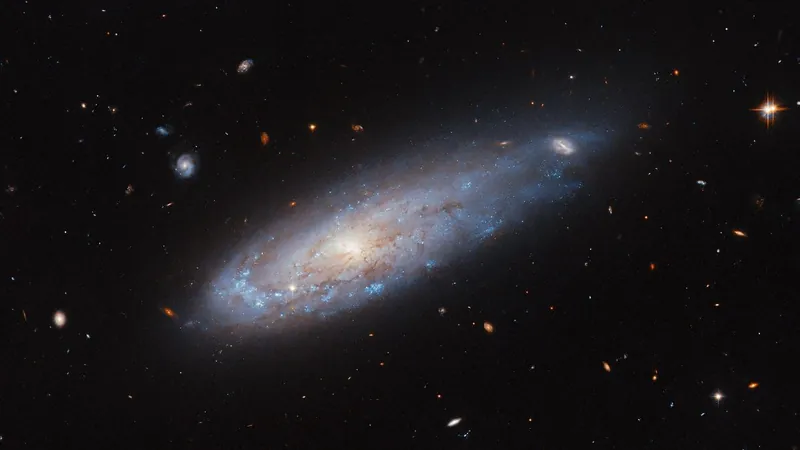
Unveiling the 'Cannonball Galaxy': Hubble's Stunning Capture of IC 3225 in Action!
2024-11-03
Author: Arjun
What’s The Buzz?
Meet the spiral galaxy IC 3225, a mesmerizing celestial marvel located an astounding 100 million light-years away in the constellation Virgo. The latest image, released by NASA on October 21, 2024, reveals a galaxy that appears to be on a high-speed trajectory through the cosmos, earning it the nickname 'Cannonball Galaxy.'
What's So Special About IC 3225?
At first sight, IC 3225 might resemble our very own Milky Way with its distinct spiral structure and radiant center. However, a closer look reveals a tale of cosmic drama. On one side, there exists a spiral arm teeming with vibrant blue stars, while the opposite side is shrouded in a chaotic, star-depleted region that resembles a tail trailing behind—much like a comet speeding through space!
NASA, through the Hubble Space Telescope, showcases this unique phenomenon, suggesting that IC 3225 has been blasted from its core, weaving through the galaxy like a high-velocity projectile. But what caused this mesmerizing trail of gas and the strange formation?
The Life of a Galaxy: It’s a Group Thing!
Galaxies, as stunning as they are, don’t float through the universe in isolation. They often exist in clusters, like IC 3225, which is one of 1,300 galaxies within the Virgo Cluster. This incredible cluster is a gravitational hub where galaxies congregate, hanging tightly to one another.
The density of the Virgo Cluster is so significant that it gives rise to an environment known as the intracluster medium—an expanse filled with exceedingly hot gas that flows amidst the galaxies. The immense gravitational pull results in galaxies orbiting the cluster at blistering speeds, leading to a phenomenon known as “ram pressure.” This pressure is believed to have stripped away some of IC 3225’s essential gas as it raced around the cluster's core!
Theories Behind Its Remarkable Shape
The captivating image showcases a leading edge that hints at star formation alongside a trailing end that appears elongated and distorted. NASA speculates that IC 3225 may have also encountered a close brush with another galaxy, where gravitational interactions could have stretched and elongated its structure.
Beyond IC 3225: The Vast Cosmic Neighborhood
The Virgo Cluster doesn’t stand alone—it’s part of a larger cosmic family known as the Virgo Supercluster, which is home to over 100 additional groups of galaxies. Spanning a colossal 100 million light-years, this supercluster is interconnected with an even grander structure known as Laniakea, a Hawaiian term meaning 'immense heaven,' which comprises about 100,000 galaxies!
As we gaze into the mysteries of the universe, IC 3225 serves as a vivid reminder of the dynamic and ever-changing nature of galaxies. What other wonders lie hidden among the stars? One thing’s for sure—there’s always more to discover in the vastness of space!

 Brasil (PT)
Brasil (PT)
 Canada (EN)
Canada (EN)
 Chile (ES)
Chile (ES)
 España (ES)
España (ES)
 France (FR)
France (FR)
 Hong Kong (EN)
Hong Kong (EN)
 Italia (IT)
Italia (IT)
 日本 (JA)
日本 (JA)
 Magyarország (HU)
Magyarország (HU)
 Norge (NO)
Norge (NO)
 Polska (PL)
Polska (PL)
 Schweiz (DE)
Schweiz (DE)
 Singapore (EN)
Singapore (EN)
 Sverige (SV)
Sverige (SV)
 Suomi (FI)
Suomi (FI)
 Türkiye (TR)
Türkiye (TR)